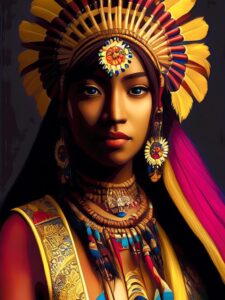 India’s Tapestry of Diversity: A Journey Through the Many Tribes of 2023
India’s Tapestry of Diversity: A Journey Through the Many Tribes of 2023
Introduction:
India, a nation celebrated for its cultural kaleidoscope, is home to a multitude of tribes, each with its unique identity, traditions, and heritage. As of 2023, the landscape of indigenous communities in India is a vibrant mosaic, reflecting the country’s rich tapestry of diversity. Exploring the various tribes that thrive across the subcontinent unveils a fascinating journey through time, culture, and the resilience of communities deeply rooted in their ancestral lands.
The Dynamic Tapestry:
In 2023, India boasts an impressive array of tribes, numbering over 700, each contributing to the nation’s cultural mosaic. From the northern reaches of Jammu and Kashmir to the southern tip of Tamil Nadu, and from the western deserts of Rajasthan to the eastern hills of Arunachal Pradesh, tribes have woven themselves into the social fabric of the nation. The diversity is not only geographical but also linguistic, with numerous languages and dialects spoken across these communities.
Linguistic Diversity:
The linguistic diversity among India’s tribes is astounding. Each tribe typically has its own language or dialect, reflecting its unique cultural heritage. For instance, the Gonds in central India speak Gondi, the Bodo tribe in Assam communicates in Bodo, and the Toda tribe in the Nilgiri Hills converses in Toda. These languages are not just a means of communication; they are repositories of folklore, mythology, and the collective wisdom of generations.
Cultural Expressions:
The cultural expressions of India’s tribes are as diverse as the landscapes they inhabit. Dance, music, art, and rituals form an integral part of their identity. From the vigorous martial dances of the Nagas to the intricate beadwork of the Bhils, each tribe’s cultural expression is a testament to its history and way of life. Festivals, often tied to the agricultural calendar or significant natural events, are celebrated with fervor and reflect the tribes’ deep connection to the land.
Economic Practices:
The economic practices of Indian tribes are as varied as the environments they inhabit. Some tribes, like the Jarawas of the Andaman Islands, engage in hunting and gathering, maintaining a sustainable lifestyle in harmony with nature. Others, such as the Todas of the Nilgiris, practice pastoralism, herding their cattle across the hilly terrain. The Warlis of Maharashtra are known for their agricultural practices, cultivating crops on the undulating hills of the Western Ghats.
Challenges Faced by Tribes:
Despite their rich cultural heritage, many tribes in India face significant challenges. Encroachment on tribal lands, displacement due to development projects, and the erosion of traditional livelihoods are among the pressing issues. Additionally, there are concerns about the preservation of languages, as globalization and urbanization often lead younger generations to adopt more widely spoken languages, contributing to the gradual loss of linguistic diversity.
Government Initiatives:
Recognizing the importance of preserving India’s tribal heritage, the government has implemented various initiatives. The PVTGs (Particularly Vulnerable Tribal Groups) receive special attention, with focused programs aimed at improving their socio-economic conditions while safeguarding their cultural identity. Educational and healthcare interventions, along with efforts to protect tribal lands, demonstrate a commitment to addressing the unique challenges faced by these communities.
Role of NGOs and Activists:
Non-governmental organizations (NGOs) and activists have played a crucial role in advocating for the rights of tribal communities. These entities often work on the ground, collaborating with tribes to address issues of land rights, education, healthcare, and cultural preservation. By amplifying the voices of tribal communities and fostering sustainable development practices, NGOs contribute to empowering these communities to shape their own destinies.
Innovations and Adaptations:
Tribes in India are not static entities; they adapt and innovate in response to changing circumstances. The Dongria Kondh of Odisha, for example, have successfully resisted mining projects that threatened their sacred lands through advocacy and legal battles. The Warlis, known for their traditional art forms, have found new markets for their products, blending tradition with entrepreneurship. These examples highlight the resilience and resourcefulness of India’s tribal communities.
Tourism and Cultural Exchange:
In recent years, there has been a growing interest in tribal tourism, providing economic opportunities for these communities while allowing visitors to experience their unique way of life. However, it is crucial to balance tourism with the need to preserve the cultural integrity of these tribes. Responsible tourism initiatives that prioritize cultural sensitivity and environmental sustainability can contribute positively to the economic well-being of tribes.
Preserving Traditional Knowledge:
The traditional knowledge held by tribal communities is a valuable resource that extends beyond cultural practices. Tribes often possess profound knowledge about local ecosystems, medicinal plants, and sustainable agricultural practices. Efforts to document and preserve this knowledge not only benefit the tribes but can also contribute to broader environmental and healthcare initiatives.
Conclusion:
As of 2023, India stands as a living testament to the extraordinary diversity of its tribes. The nation’s indigenous communities have weathered the winds of change, adapting and preserving their unique identities amidst the complexities of the modern world. Their stories, languages, arts, and traditions collectively weave a rich tapestry that enhances the cultural vibrancy of India. In acknowledging and celebrating this diversity, we not only honor the heritage of India’s tribes but also contribute to the global tapestry of human civilization. The journey through India’s tribes is an ongoing exploration, a narrative of resilience, adaptation, and the enduring spirit of communities deeply connected to their roots.